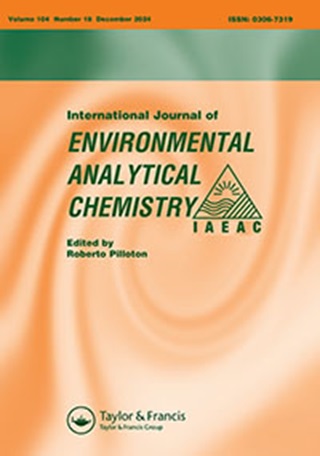用ICP-MS评估皮革中Cd、Cu、Pb和Zn的浓度:一种环保方法的多变量分析
IF 2.5
4区 化学
Q3 CHEMISTRY, ANALYTICAL
International Journal of Environmental Analytical Chemistry
Pub Date : 2023-10-23
DOI:10.1080/03067319.2023.2267976
引用次数: 0
摘要
由于制革工业中使用的金属络合染料,可能会在皮革中存在潜在的有毒金属。然而,关于皮革中金属测定的出版物很少,而且大多数样品制备程序仍然很耗时。因此,提出了一种简单、直接的超声辅助萃取(UAE)制样方法,用于ICP-MS法测定皮革样品中的Cd、Cu、Pb和Zn。采用全因子设计23考察提取条件。条件为100 mg: 1.0 mL(样品:HNO3 14.0 mol L−1),超声辅助提取时间为55 min,温度为75±3℃。通过与微波辅助消化法(MWAD)的结果比较,评价了该方法的准确性。根据学生t检验(α = 0.05)和线性回归分析,UAE的结果与MWAD的结果在统计学上相似。检出限(LOD)在mg kg−1范围内,方法精密度(RSD <11%)适用于皮革中分析物的测定。该方法成功地应用于18种不同皮革样品的分析。Cd < 0.3 ~ 53.19 mg kg - 1, Cu <0.2 ~ 484.61 mg kg - 1, Pb <0.02 ~ 211.31 mg kg - 1, Zn <0.02 ~ 379.22 mg kg - 1。与传统的酸消化样品制备方法相比,该方法操作简单,速度快。此外,根据绿色分析化学,该方法在生态尺度上得到82分,证实了该方法是环保的。致谢致谢致谢致谢致谢致谢致谢致谢致谢致谢致谢致谢致谢致谢致谢致谢致谢致谢致谢致谢致谢致谢致谢致谢致谢致谢致谢致谢致谢致谢致谢致谢致谢致谢致谢致谢致谢致谢致谢致谢致谢致谢B.O.G, B.L.F和T.T.M获得了CNPq的奖学金,F.L.G获得了CAPES的奖学金。esc有CNPq的研究奖学金。作者还感谢Flaticon (https://www.flaticon.com)和Canva (https://www.canva.com)在图中使用的图标。披露声明作者未报告潜在的利益冲突。数据可用性声明本研究过程中产生或分析的所有数据均包含在本文中。本研究由Conselho Nacional de Desenvolvimento Científico e Tecnológico - CNPq资助[资助ID: 421245/2018-2]。本文章由计算机程序翻译,如有差异,请以英文原文为准。
Assessment of Cd, Cu, Pb, and Zn concentrations in leather by ICP-MS: a multivariate analysis of an eco-friendly approach
ABSTRACTDue to the metal-complex dyes used in tannery industries, potentially toxic metals can be present in leather. However, publications regarding metal determination in leather are scarce, and most sample preparation procedures are still time-consuming. Therefore, a simple and straightforward sample preparation approach using ultrasound-assisted extraction (UAE) was proposed for the determination of Cd, Cu, Pb and Zn in leather samples by ICP-MS. A full factorial design 23 was used to investigate the extraction conditions. Fitted conditions were obtained at a ratio of 100 mg: 1.0 mL (sample:HNO3 14.0 mol L−1), ultrasound-assisted extraction time of 55 min at 75 ± 3°C. The method´s accuracy was evaluated through the comparison of results with those obtained using microwave-assisted digestion (MWAD) approach. The UAE results were statistically similar to the MWAD, according to the Student t-test (α = 0.05) and linear regression analysis. Limits of detection (LOD), at mg kg−1 range, and method precision (RSD <11%) were suitable for the analytes´ determination in leather. The proposed method was successfully applied to analyse 18 different leather samples. The results were < 0.3 to 53.19 mg kg−1 for Cd, <0.2 to 484.61 mg kg−1 for Cu, <0.02 to 211.31 mg kg−1 for Pb and < 0.02 to 379.22 mg kg−1 for Zn, respectively. The proposed method is simple and faster than the traditional acid digestion sample preparation. Moreover, according to green analytical chemistry, the method scored 82 points on the Eco-Scale, confirming the proposed method as environmentally friendly.KEYWORDS: Leathermetalsmultivariate analysisultrasound-assisted extraction AcknowledgmentsThe authors are thankful to Conselho Nacional de Desenvolvimento Científico e Tecnológico (CNPq) and Coordenação de Aperfeiçoamento de Pessoal de Nível Superior (CAPES) for their financial support. B.O.G, B.L.F and T.T.M have scholarships from CNPq, and F.L.G has a scholarship from CAPES. E.S.C. has a research scholarship from CNPq. The authors are also thankful to Flaticon (https://www.flaticon.com) and Canva (https://www.canva.com) for the icons used in the Figures.Disclosure statementNo potential conflict of interest was reported by the authors.Data availability statementAll data generated or analysed during this study are included in this article.Additional informationFundingThis work was funded by the Conselho Nacional de Desenvolvimento Científico e Tecnológico – CNPq [Grant ID: 421245/2018-2].
求助全文
通过发布文献求助,成功后即可免费获取论文全文。
去求助
来源期刊
CiteScore
5.90
自引率
7.70%
发文量
373
审稿时长
4.4 months
期刊介绍:
International Journal of Environmental Analytical Chemistry comprises original research on all aspects of analytical work related to environmental problems. This includes analysis of organic, inorganic and radioactive pollutants in air, water, sediments and biota; and determination of harmful substances, including analytical methods for the investigation of chemical or metabolic breakdown patterns in the environment and in biological samples.
The journal also covers the development of new analytical methods or improvement of existing ones useful for the control and investigation of pollutants or trace amounts of naturally occurring active chemicals in all environmental compartments. Development, modification and automation of instruments and techniques with potential in environment sciences are also part of the journal.
Case studies are also considered, particularly for areas where information is scarce or lacking, providing that reported data is significant and representative, either spatially or temporally, and quality assured. Owing to the interdisciplinary nature of this journal, it will also include topics of interest to researchers in the fields of medical science (health sciences), toxicology, forensic sciences, oceanography, food sciences, biological sciences and other fields that, in one way or another, contribute to the knowledge of our environment and have to make use of analytical chemistry for this purpose.

 求助内容:
求助内容: 应助结果提醒方式:
应助结果提醒方式:


